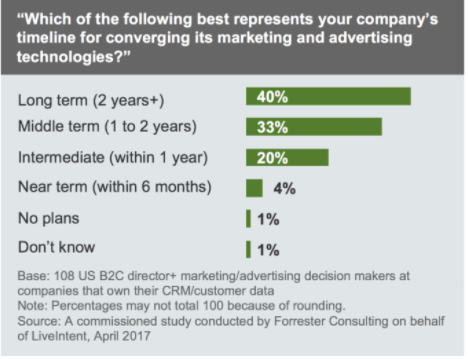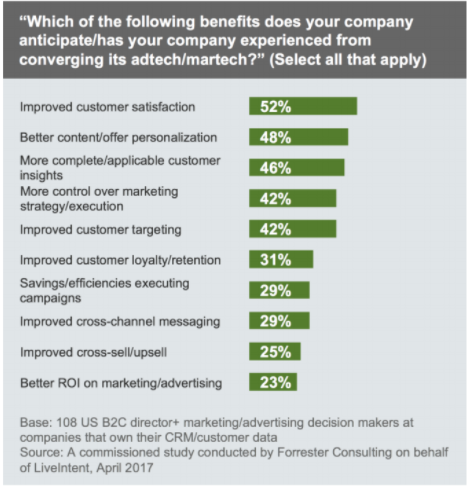Ad tech and mar tech convergence has been one of this year’s hot topics as the industry has seen a growing number of mergers and acquisitions between the two spaces, resulting in more combined data and solutions. In a move to evaluate the state of advertising and marketing technology, LiveIntent commissioned Forrester to release a new study titled ‘Kick-start your adtech/martech convergence’ investigating the industry.
According to the research, marketers recognise the integration is important but only 35% are taking action, with 7% of companies admitting they don’t have any plans around the convergence and 58% at a ‘talking’ stage.
The reason behind this might be a lack of knowledge; more than half of the respondents believe a quarter or more of their colleagues don’t actually understand the difference between advertising and marketing tech.
Another challenge marketers face is a struggle with data capabilities. Only 39% of those surveyed believe their companies are capable of campaign measurement and attribution as well as data activation, and less than half (43%) can run customer insights and analytics.
Internal divisions and data silos have been pinpointed as major barriers standing in the way of the advertising and marketing tech integration. Almost half of the respondents find it difficult to work across internal silos (42%), and many (32%) are concerned about technology. Marketers are also worried about potential difficulties coordinating with external partners (31%), integrating advertising marketing with customer data (30%) and lack of executive buy-in (28%).
With these stats in mind, the research suggests that although the integration is happening, it remains a long-term goal for most firms.
Shaping the future of marketing
While ad tech entails advertisements buying and selling systems, mar tech incorporates systems that manage customers, analytics, workflows, and content. Combined, the technology would shape the future of marketing by eliminating disjointed customer experiences. LiveIntent’s founder and CEO, Matt Keiser, believes the integration will enable marketers to reach “real people” at scale.
“This ability to do people-based marketing is the heart of a cross-channel marketing platform,” he commented.
Marketers are well aware of the benefits the convergence could bring. Among the perks, Keiser counts the ability to seamlessly extend customer relationship beyond traditional marketing channels to include display, mobile web and video, aiming to “never again” have to treat customers like strangers.
It is improved customer satisfaction and better personalisation marketers identify as the main benefits.
By building an infrastructure for cross-channel customer journeys, advertising and marketing tech integration will have long-term implications, changing the way brands interact with customers. For marketers, marrying the ad tech and mar tech capabilities is a key way to pursue what’s been this year’s key buzzword: people-based marketing.
Although marketers face a number of challenges on their journey to full integration, Keiser is optimistic the convergence will impact big and soon.
“Soon, we will see a preponderance of marketing campaigns that are able to reach people where they are spending time, irrespective of browser and device thanks to the emergence of identity graphs and people-based marketing,” he concluded.




